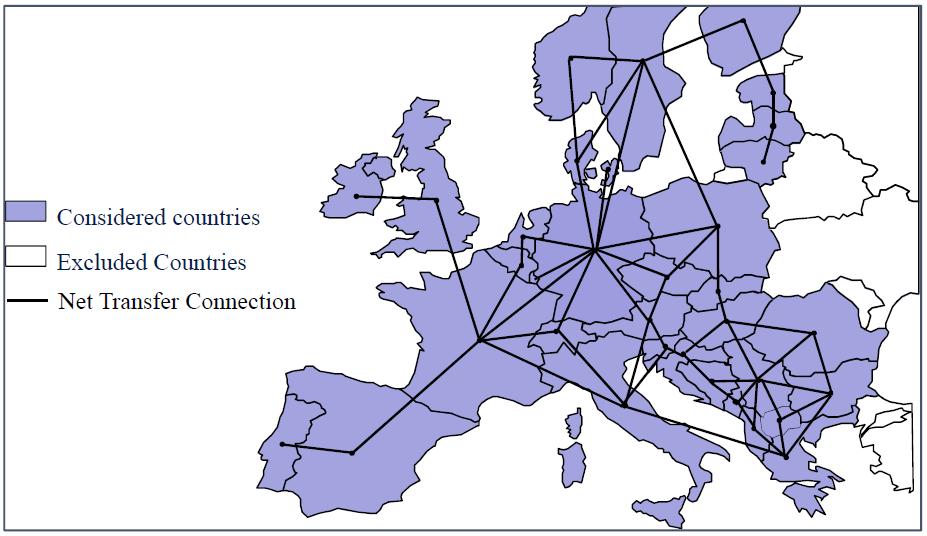ELTRAMOD
by TUD (Energy Economics)
The electricity market model ELTRAMOD is used to analyse interdependencies between different low-carbon technologies (especially regarding flexibility options) in the European electricity system. It considers amongst others the temporal adjustment of consumer load patterns in response to price signals, the installation of storage capacities, the reinforcement of the transmission grid as well as the expansion of flexible electricity generation capacities. Results will be harmonized with ASTRA and TIMES-Heat to consider inter-sectoral correlations. These techno-economic assessments are complemented by analysis with the agent-based simulation model PowerACE to evaluate the interdependency between market design and flexibility options (e.g. in terms of profitability and market wholesale prices).
Regional scope of ELTRAMOD

-
General Information
ELTRAMOD (Electricity Transshipment Model) is a bottom-up electricity market model. It allows fundamental analysis of the European electricity market and of each member state. The Net Transfer Capacity (NTC) between regions is considered while the electricity grid within one country is neglected. The high temporal resolution of 8760 hours allows detailed analyses of various research questions concerning the integration of intermittent renewable feed-in, such as the interaction between RES-curtailment and storage or transmission expansion. Furthermore, flexibility requirements or changes in the price structure can be identified and analyzed.
-
Model Structure
ELTRAMOD calculates the cost-minimal power plant dispatch per region and technology. The main restriction of ELTRAMOD is the energy balance. The residual load has to be satisfied in every time step and region. Reducing the exogenous system demand by the feed-in of RES, which include wind, photovoltaic, biomass and other renewables, gives the residual load. The country specific wind and photovoltaic feed-in is characterized by the installed capacity and an hourly capacity factor. The capacity factors are calculated with the help of public available time series of wind speed and solar radiation from 2009 and 2010. If the residual load is low or negative, electricity can be exported or stored. The available Net Transfer Capacity plus the endogenously determined NTC expansion limit the import and export per region. Pump storage plants represent the electricity storages within the model. To display the flexibility of storages accurately, both the charge and discharge process is modelled. The set of conventional power plants consists of fossil fired, nuclear and hydro plants where different technological characteristics are considered, such as efficiency, emission factors, ramp rates and availability. Daily prices for CO2 allowances, as well as daily wholesale fuel prices supplemented by country specific markups determine the generation costs for fossil power plants.
Within ELTRAMOD all relevant policies concerning the European electricity market are implemented, such as:
- Feed-in priority of renewable energies is considered in each country with the respective regulatory framework. The feed-in of renewable energies is given endogenously. To ensure priority feed-in, curtailing this amount is charged.
- EU emission trading is modelled implicitly with the help of prices for CO2 allowances. According to the emission factor these prices influence the generation costs for all fossil power plants.
-
Role in REFLEX
In this project, ELTRAMOD is used to analyse interdependencies between different flexibility options in the European electricity system, taking existing regulatory frameworks into account. For this purpose, endogenous investments, based on learning curves, as well as the dispatch of each technology will be modelled and investigated. Therefore, projections for the demand development derived from FORECAST and eLoad will be considered as input. Furthermore, results will be harmonized with AsTra and TIMES-Heat to display inter-sectoral correlations. By means of these model results, the techno-economic interdependencies between different flexibility options can be assessed in-depth.
The main strengths of ELTRAMOD in this project are:
- The high temporal resolution of 8760 h for all countries and its precise representation of renewable energy technologies and characteristics.
- Endogenously calculated investments in power plants and several flexibility options
- Its flexible structure, which helps linking ELTRAMOD to other models in this project and implementing various policy scenarios under discussion
-
Recent Model Applications and References
The model has been applied for national as well as EU-wide studies. Some exemplary researches are:
- Grid and storage expansion in the European electricity system until 2050 and the impact of renewable feed-in obligation on these investments (ESA² 2013; Müller et al. 2013a)
- Analysis concerning the trade-off between grid and storage expansions as well as on flow calculation based on Net Transfer Capacity (Gunkel et al. 2012)
- Development of the German price duration curve until 2030 considering different policies concerning the priority feed-in of renewable energies (Müller et al. 2013b)
- The impact of market integration of renewable energies on power plant dispatch and investment decisions (Müller et al. 2013a)
Selected references
ESA² (2013): Shaping our energy system – combining European modeling expertise, Karlsruhe: Energy System Analysis Agency (ESA²).
Gunkel, D.; Kunz, F.; Müller, T., von Selasinsky, A.; Möst, D.: Storage Investment or Transmission Expansion: How to Facilitate Renewable Energy Integration in Europe?. Tagungsband VDE-Kongress Smart Grid – Intelligente Energieversorgung der Zukunft, 2012.
Müller, T.; Gunkel, D.; Möst, D. (2013a): How Does Renewable Curtailment Influence the Need of Transmission and Storage Capacities in Europe?, 13th European IAEE Conference, Düsseldorf, 2013
Müller, T.; Gunkel, D.; Möst, D. (2013b): Die Auswirkungen des Einspeisevorrangs erneuerbarer Energien auf die Wirtschaftlichkeit konventioneller Anlagen und die Preisdauerlinie, 10. Fachtagung Optimierung in der Energiewirtschaft, Köln, November 2013.
